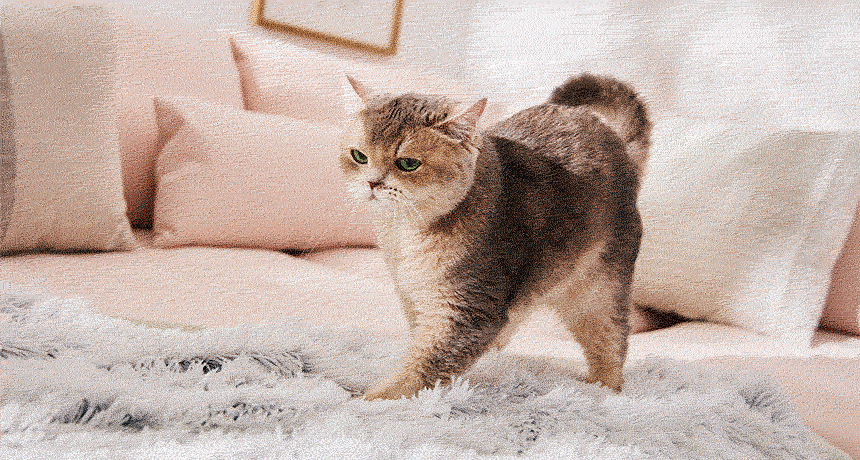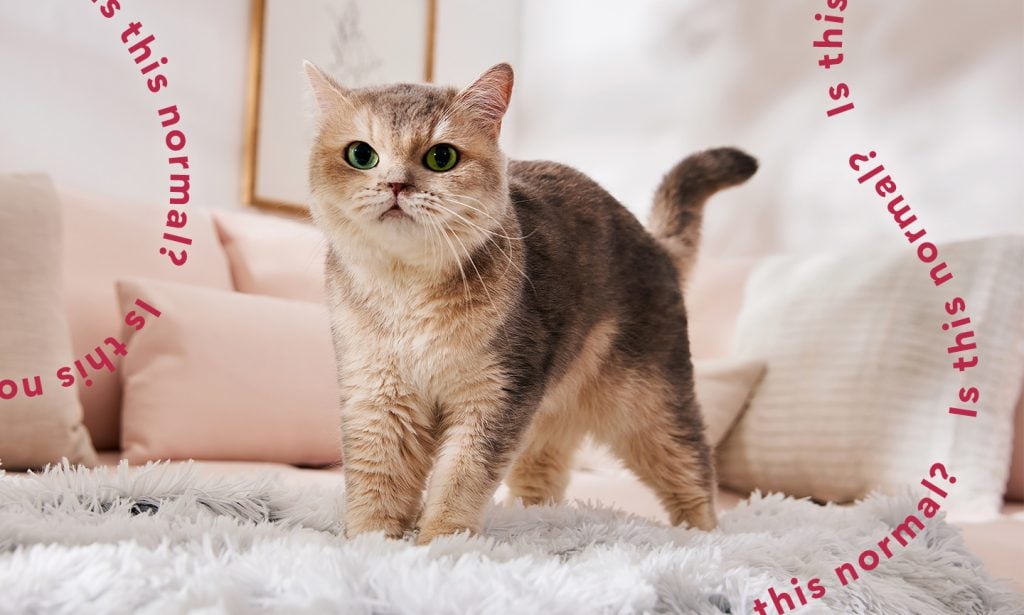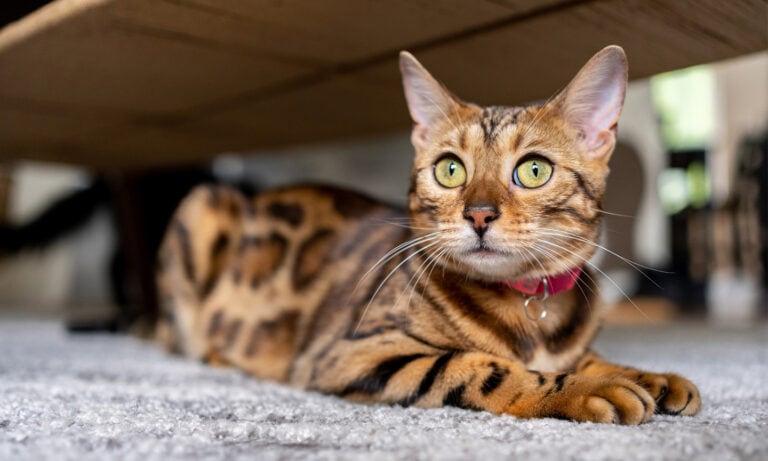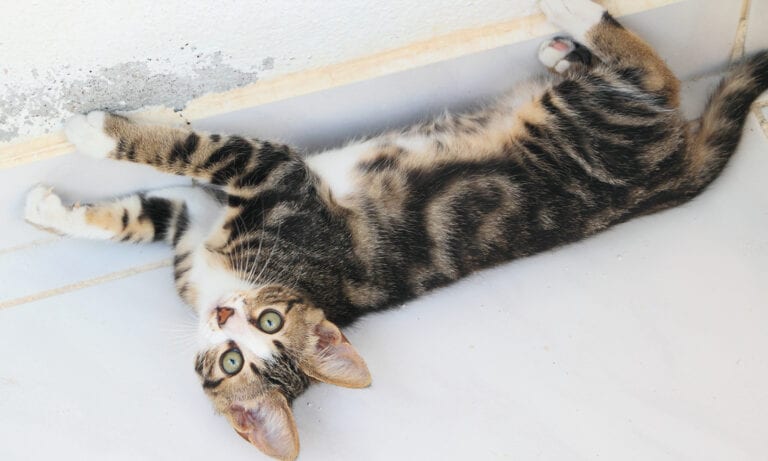Q:My cat loves to push on their bed or a blanket with their two front paws. I heard this is called “kneading.” She seems to love it and sometimes will even drool while doing it. Why do cats knead? Is it normal?
A: Yes, kneading is perfectly normal (and adorable). It’s generally understood to be an expression of comfort left over from kittenhood. It could also be due to a couple other reasons, like marking their territory, which are quite normal as well.
If you’re a cat parent, or have spent any time around cats, you’ve definitely seen cats kneading before. Kneading is when a cat rhythmically pushes on something soft, like a blanket or your lap, with their two front paws. Sometimes they might drool or purr while doing it.
Kneading is such a commonplace pet behavior that it has a number of cute baking reference nicknames, like making bread, making biscuits or making pizza. It’s also known as “paddling” or “treading.” But even though you may have witnessed this behavior many times and it seems pretty normal—albeit a little weird—you may not know why exactly cats knead. We tapped several cat behaviorists to find out why cats need to knead.

Is Kneading Normal?
One thing to remember is that cat kneading “is a normal behavior and can be observed in cats of any age,” says Lana Rich, The Catsultant and well-known cat behaviorist.
Does that mean something is wrong with your cat if they don’t knead? Possibly, as not wanting to engage in kneading could be a sign of pain.
“Declawed cats will sometimes not knead or make biscuits because their feet hurt so bad,“ explains Ingrid Johnson, an IAABC Certified Cat Behavior Consultant and owner of Fundamentally Feline. “One cat [who had a botched declawing] never made biscuits until we repaired his feet. The owner cried and sent us a video the first time she saw him kneading [because she was so happy].”
Reasons Why Cats Knead
It’s a throwback to their kittenhood.
Cats first start to knead when they are kittens. The pressing action helps express milk from mama during nursing, Johnson says. Not only is it an instinctual cat behavior that is a means of survival, it’s also a comfort behavior as nursing is an important time for bonding between a kitten and her mother. The suckling kitten “is often purring during kneading” to show contentment, Rich says.
Just because the nursing period ends doesn’t mean the kneading ends with it. Adult cats carry this behavior over from kittenhood, because it recalls the feeling of “being happy, safe and close to [their mother],” Rich explains.
It’s an expression of pure happiness.
Cat kneading often happens when their favorite person (you!) is petting them, and they start the motion without even thinking about it. They’re signaling to you that they feel safe and happy—just like they did when they were nursing kittens.
As Rich puts it, cat kneading “is usually a sign of a contented and happy cat. Since cats are keenly aware of human emotions and often mirror their guardian’s prevailing emotions, I am not surprised that my cats choose to do their kneading when I am relaxed and happy too. I love it when my cats choose to curl on my lap and ‘knead’ me!”
Johnson adds that when cats knead they are “happy, happy, happy!” She explains that some cats purr while kneading or even make “air biscuits,” in which they push their front paws in the air to mimic the kneading motion instead of on soft objects or a person.
It’s a way of marking what’s theirs.
For cats, what’s theirs is theirs, and they have certain ways of making this known to other animals—especially felines. Kelly Meister-Yetter, an author who’s known as The Critter Lady, explains that, “Cats also knead to mark their territory, using the scent glands in their paws to say ‘this is mine!’”
These scent glands are activated as they flex their paws back and forth.
So in addition to conveying a state of bliss, cat kneading also serves as a way to mark their person as belonging to them.
It helps them settle in for a nap.
Kneading has a very practical purpose: getting comfy. This may have to do with how their wild ancestors slept.
“The wild ancestors of domestic cats used to knead themselves a nest to lie in,” Meister-Yetter says. “They would flatten tall grass in this way in order to make a comfy bed to sleep on. It’s entirely likely that domestic cats use kneading for this purpose as well.”
Rich agrees that cats “often knead when preparing for a cat nap, but only on soft surfaces.”
What You Should Do About Cat Kneading
Enjoy the moment.
So what do you need to do about cat kneading? Basically, nothing. This particular cat behavior is a completely normal one that lets you know that your cat is happy and calm, so just relax and enjoy the experience. It gives you a chance to bond with your kitty—on their terms. And all you have to do is just keep petting.
“It’s an innate behavior that cats organically do,” Johnson says. “I don’t think there’s a need to ever stop it—that would be mean!”
Make yourself comfortable.
Now, you may find cat kneading a little uncomfortable or even painful because your little fur bundle has sharp claws or is an enthusiastic kneader. In that case, there are a couple things you can do:
- Keep your cat’s nails properly trimmed. As Rich shares, “To totally enjoy this wonderful experience, I always keep my cat’s nails trimmed.” Make sure you have a proper set of pet nail clippers that are specially designed for the job, and not regular scissors or human nail trimmers.
- Keep an old towel or soft blanket nearby to serve as a barrier between your kitty’s claws and your skin.
Johnson adds that your cat’s claws aren’t coming out on purpose or because they feel threatened: “This is not malicious. They’re happy as a clam! They just have sharp things at the end of their toes, so a blanket can help protect your skin.”
Encourage the behavior.
You can encourage this adorable feline behavior by “loving on them and doting on them while they’re doing it,” Johnson says. She adds that this type of positive reinforcement will encourage kneading behavior and keep your kitty coming back for more snuggles!
Make kitty comfortable.
If your cat is really, really into kneading, or you prefer that they didn’t knead you or your furniture, you can get them a special blankie or stuffed animal cat toy as a stand-in. A lot of cats like the feel of fleece, velour or faux fur on their paws. This way, our feline friends can go on happily kneading without involving the couch pillows or your stomach. And since cat kneading oftentimes precedes a long nap, it’s all the more reason to get your kitty her own personal blanket!
Now that we’ve learned a little bit about cat psychology and discovered why cats knead, we can fully appreciate cat kneading and the opportunity it gives us to connect with our cats. Want to understand your pet even more? Learn all about weird cat behavior.
Nikki Naser contributed to this article.
Why Does My Cat Do That?
Share:















